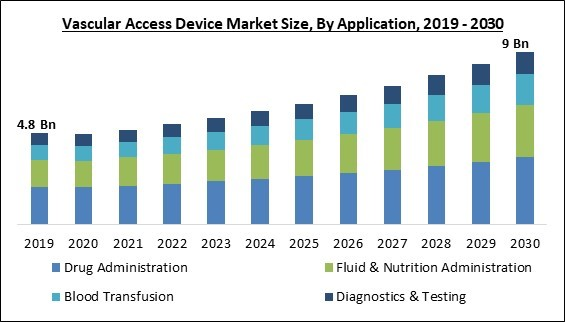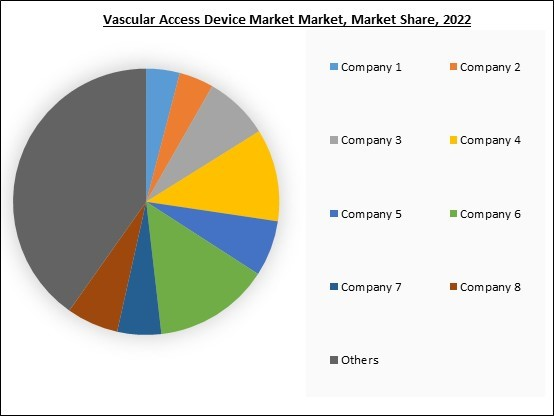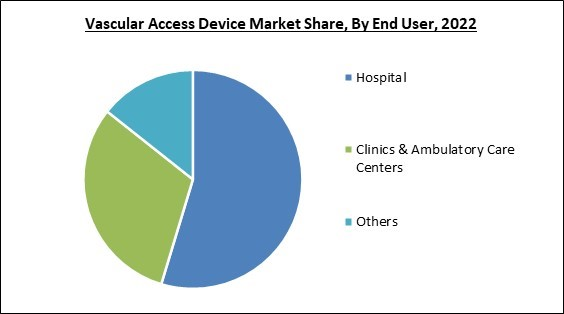The Global Vascular Access Device Market size is expected to reach $9 billion by 2030, rising at a market growth of 7.2% CAGR during the forecast period.
Central venous access using tunneled catheters can be utilized for hemodialysis, feeding, fluid transfusion, and pharmaceutical infusion. Therefore, the tunneled catheters segment will capture around 45% share of the market by 2030. Patients can continue intravenous therapy after being discharged from the hospital with the placement of tunneled catheter. Interventional radiologists (IR) or general or vascular surgeons often insert tunneled catheters. Some of the factors impacting the market are rising prevalence of lifestyle diseases, growing ageing population, and costly installation and maintenance.
The main cause of mortality worldwide, according to the World Health Organization in 2021, is cardiovascular disease (CVD). According to projections, 17.9 million deaths worldwide from CVDs occurred in 2019, accounting for 32% of all fatalities. Heart attacks and strokes were the main causes of 85% of these fatalities. For instance, the number of CVD fatalities is predicted to increase to over 22.2 million in 2030 and 32.3 million in 2050, according to the World Heart Federation's Vision 2030. Furthermore, The WHO reports that people are living longer overall. The majority of people today likely live until their sixties and beyond. By 2030, one in six people will be 60 years of age or older. 1.4 billion people will be above the age of 60 by this time, up from 1 billion in 2020. There will be 2.1 billion people worldwide who are 60 years of age or older by 2050. According to projections, there will be 426 million individuals who are 80 years of age or older by the year 2050. Thus, the market will grow due to the rising prevalence of several health problems, particularly CKD, CVDs, and cancer and the increase in growth of ageing population.
However, Vascular access devices (VADs) are highly expensive medical equipment, and the cost of the product varies depending on the type of VADs utilized during an operation. Numerous studies reveal that vascular access expenses are much greater for patients in whom an arteriovenous fistula (AVF) attempt is failed, even if a working AVF is undoubtedly the finest type of vascular access. Additionally, complications such as central catheter bloodstream infections or occlusions can significantly increase the cost of the procedure. In the coming years, the market growth is anticipated to be constrained by their high placement and maintenance costs.
Moreover, the COVID-19 pandemic had a severe impact on the world’s economy. The outbreak affected almost all industries, either in a positive or negative manner. The market was negatively impacted by the pandemic outbreak in the initial months. The COVID-19 pandemic put a strain on the world’s healthcare system. During the pandemic, a worldwide strategy to maintain the healthcare system was essential. Due to the severity of chronic disease, many governments allowed for its treatment even during the pandemic. Therefore, the pandemic had a negative impact on the market.
The leading players in the market are competing with diverse innovative offerings to remain competitive in the market. The above illustration shows the percentage of revenue shared by some of the leading companies in the market. The leading players of the market are adopting various strategies in order to cater demand coming from the different industries. The key developmental strategies in the market are Acquisitions, and Partnerships & Collaborations.
The market research report covers the analysis of key stakeholders of the market. Key companies profiled in the report include ICU Medical, Inc., Teleflex, Inc., B. Braun Melsungen AG, Medtronic PLC, Terumo Corporation, Becton, Dickinson and Company, AngioDynamics, Inc., Edwards Lifesciences Corporation, Nipro Corporation and Romsons.
Central venous access using tunneled catheters can be utilized for hemodialysis, feeding, fluid transfusion, and pharmaceutical infusion. Therefore, the tunneled catheters segment will capture around 45% share of the market by 2030. Patients can continue intravenous therapy after being discharged from the hospital with the placement of tunneled catheter. Interventional radiologists (IR) or general or vascular surgeons often insert tunneled catheters. Some of the factors impacting the market are rising prevalence of lifestyle diseases, growing ageing population, and costly installation and maintenance.
The main cause of mortality worldwide, according to the World Health Organization in 2021, is cardiovascular disease (CVD). According to projections, 17.9 million deaths worldwide from CVDs occurred in 2019, accounting for 32% of all fatalities. Heart attacks and strokes were the main causes of 85% of these fatalities. For instance, the number of CVD fatalities is predicted to increase to over 22.2 million in 2030 and 32.3 million in 2050, according to the World Heart Federation's Vision 2030. Furthermore, The WHO reports that people are living longer overall. The majority of people today likely live until their sixties and beyond. By 2030, one in six people will be 60 years of age or older. 1.4 billion people will be above the age of 60 by this time, up from 1 billion in 2020. There will be 2.1 billion people worldwide who are 60 years of age or older by 2050. According to projections, there will be 426 million individuals who are 80 years of age or older by the year 2050. Thus, the market will grow due to the rising prevalence of several health problems, particularly CKD, CVDs, and cancer and the increase in growth of ageing population.
However, Vascular access devices (VADs) are highly expensive medical equipment, and the cost of the product varies depending on the type of VADs utilized during an operation. Numerous studies reveal that vascular access expenses are much greater for patients in whom an arteriovenous fistula (AVF) attempt is failed, even if a working AVF is undoubtedly the finest type of vascular access. Additionally, complications such as central catheter bloodstream infections or occlusions can significantly increase the cost of the procedure. In the coming years, the market growth is anticipated to be constrained by their high placement and maintenance costs.
Moreover, the COVID-19 pandemic had a severe impact on the world’s economy. The outbreak affected almost all industries, either in a positive or negative manner. The market was negatively impacted by the pandemic outbreak in the initial months. The COVID-19 pandemic put a strain on the world’s healthcare system. During the pandemic, a worldwide strategy to maintain the healthcare system was essential. Due to the severity of chronic disease, many governments allowed for its treatment even during the pandemic. Therefore, the pandemic had a negative impact on the market.
Application Outlook
Based on application, the market is fragmented into drug administration, fluid & nutrition administration, blood transfusion, and diagnostics & testing. In 2022, the drug administration segment held the highest revenue share in the market. This is needed so that intravenous (IV) antibiotics can be delivered frequently or continuously via vascular access devices, which offer bloodstream access. Vascular access devices are helpful for people with cystic fibrosis or other disorders who need IV antibiotic medication for a longer period than a few days, such as during an exacerbation.The leading players in the market are competing with diverse innovative offerings to remain competitive in the market. The above illustration shows the percentage of revenue shared by some of the leading companies in the market. The leading players of the market are adopting various strategies in order to cater demand coming from the different industries. The key developmental strategies in the market are Acquisitions, and Partnerships & Collaborations.
End-user Outlook
By end user, the market is classified into hospitals, clinics & ambulatory care centers, and others. The clinics and ambulatory care centers segment projected a prominent revenue share in the market in 2022. Vascular access devices increase patient quality of life in clinics and ambulatory care. Instead of needing to drive to the hospital or a clinic, individuals can now receive many therapies via vascular access devices in the convenience of their own homes.Type Outlook
On the basis of type, the market is segmented into central vascular access devices, peripheral vascular access devices, and accessories. In 2022, the central vascular access device segment dominated the market with the maximum revenue share. The widespread use of central vascular access devices in chemotherapy, treating cardiovascular diseases, and managing chronic kidney diseases are responsible for this supremacy. CVAD provides long-term medical care for cancer, infections, or pain, as well as sustenance.Regional Outlook
Region wise, the market is analyzed across North America, Europe, Asia Pacific, and LAMEA. In 2022, the North America region generated the highest revenue share in the market. An advantageous reimbursement framework, the presence of key players, and significant government funding to develop cutting-edge medical devices all contribute to the region's market expansion. In addition, the government's initiatives, growing healthcare expenses, and increased disposable income also affect market growth.The market research report covers the analysis of key stakeholders of the market. Key companies profiled in the report include ICU Medical, Inc., Teleflex, Inc., B. Braun Melsungen AG, Medtronic PLC, Terumo Corporation, Becton, Dickinson and Company, AngioDynamics, Inc., Edwards Lifesciences Corporation, Nipro Corporation and Romsons.
Scope of the Study
By Application
- Drug Administration
- Fluid & Nutrition Administration
- Blood Transfusion
- Diagnostics & Testing
By End-user
- Hospital
- Clinics & Ambulatory Care Centers
- Others
By Type
- Central Vascular Access Device
- Tunneled Catheters
- Peripherally Inserted Central Catheters
- Non-tunneled Catheters
- Implanted Ports
- Peripheral Vascular Access Device
- Peripheral Midlines Devices
- Peripheral Short Devices
- Butterfly/winged Steel Needles
- Accessories
By Geography
- North America
- US
- Canada
- Mexico
- Rest of North America
- Europe
- Germany
- UK
- France
- Russia
- Spain
- Italy
- Rest of Europe
- Asia Pacific
- China
- Japan
- India
- South Korea
- Singapore
- Malaysia
- Rest of Asia Pacific
- LAMEA
- Brazil
- Argentina
- UAE
- Saudi Arabia
- South Africa
- Nigeria
- Rest of LAMEA
Key Market Players
List of Companies Profiled in the Report:
- ICU Medical, Inc.
- Teleflex, Inc.
- B.Braun Melsungen AG
- Medtronic PLC
- Terumo Corporation
- Becton, Dickinson and Company
- AngioDynamics, Inc.
- Edwards Lifesciences Corporation
- Nipro Corporation
- Romsons
Unique Offerings
- Exhaustive coverage
- The highest number of Market tables and figures
- Subscription-based model available
- Guaranteed best price
- Assured post sales research support with 10% customization free
Table of Contents
Chapter 1. Market Scope & Methodology
Chapter 2. Market at a Glance
Chapter 3. Market Overview
Chapter 4. Competition Analysis - Global
Chapter 5. Global Vascular Access Device Market by Application
Chapter 6. Global Vascular Access Device Market by End User
Chapter 7. Global Vascular Access Device Market by Type
Chapter 8. Global Vascular Access Device Market by Region
Chapter 9. Company Profiles
Companies Mentioned
- ICU Medical, Inc.
- Teleflex, Inc.
- B. Braun Melsungen AG
- Medtronic PLC
- Terumo Corporation
- Becton, Dickinson and Company
- AngioDynamics, Inc.
- Edwards Lifesciences Corporation
- Nipro Corporation
- Romsons
Methodology

LOADING...











